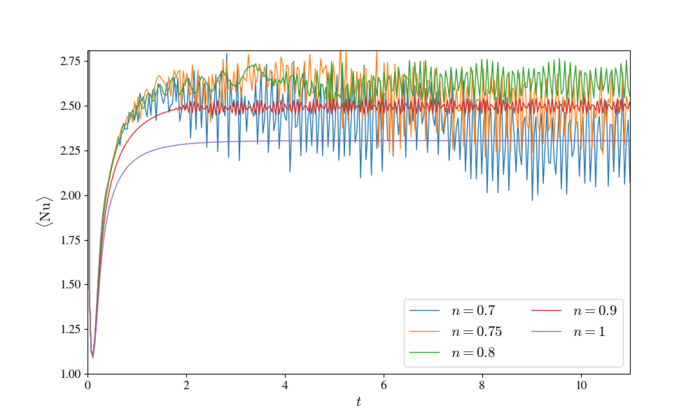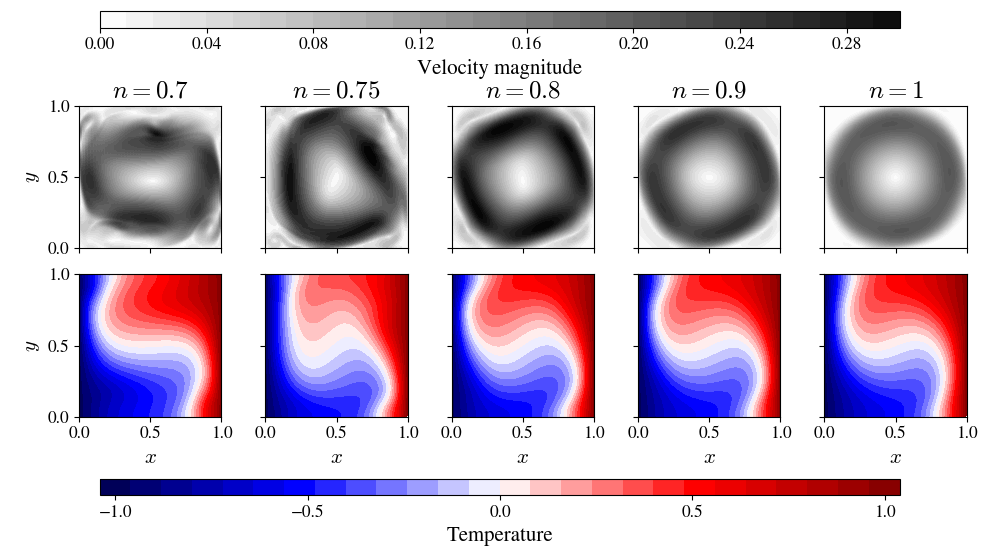Non-Newtonian fluid
Click here to return back to Fluid Mechanics
Introduction
Other fluid mechanics examples have assumed that the fluids in question are Newtonian, but that is not always the case when dealing with real world applications. Many significant fluids exhibit non-Newtonian behaviour with examples including blood, foodstuffs, polymer melts... Newtonian fluids have a linear relationship between viscous stress and shear rate but that is no longer true for non-Newtonian fluids.
Some fluids exhibit increasing or decreasing viscosity with increasing shear rate which is the simplest form of non-Newtonian behaviour that we will tackle in the following sections. Some act as solids at small stress but begin flowing when sufficiently disturbed, while others behaviour depends on the duration of movement and applied stress.
Model formulation
Viscous forces are a result of velocity differentials within the fluid and are therefore connected with the velocity gradient. We are interested in the symmetric part that excludes the rotational contributions. Shear rate tensor $\dot{u}$ for incompressible fluids can be expressed as $$ \dot{u}=\frac{1}{2}\left(\boldsymbol{\nabla} \boldsymbol{v}+(\boldsymbol{\nabla} \boldsymbol{v})^{\top}\right), $$ where $\boldsymbol{v}$ denotes the fluid velocity. We introduce viscosity $\mu$ through a generalized Newton's law of viscosity with viscous stress tensor $\tau$ expressed as $$ \tau = \mu \dot{u}. $$ In general $\mu$ is an arbitrary tensor but usually reduces to a scalar value due to isotropic properties of fluids. Non-Newtonian fluids are fluids where viscosity is a function of shear stress and duration of stress. There are many, often quantitative, models of varying complexities used to describe the viscosity of various non-Newtonian fluids.
We limit ourselves to Ostwald-de Waele power law model $$ \mu = \mu_0 \left\| \dot{u} \right\| ^{n-1} = \mu_0 \left( 2 \dot{u}{:}\dot{u} \right) ^\frac{n-1}{2}, $$
which is one of the simplest non-Newtonian viscosity models. We introduced two parameters used to fit the model to the experimental data for the fluid in question. Viscosity constant $\mu_0$ used as a scaling factor and non-Newtonian power index $n$ that describes the behaviour. Model with $n < 1$ describes shear-thinning (pseudoplastic), $n = 1$ Newtonian and $n > 1$ shear thickening (dilatant) fluids.
We will focus on shear thinning fluids as their behaviour of reduced viscosity at higher velocity gradients leads towards interesting behaviour with decreasing $n$.
de Vahl Davis example
We take a closer look at the behaviour of non-Newtonian fluid in a natural convection driven flow within a square cavity. The convection is driven by differentially heated east and west walls with the north and south walls thermally insulated as is schematically shown in Figure 1.
This is a common benchmark with existing solutions that we can compare our meshless implementation against. Convergence and comparison with the benchmark article is shown in Figure 2 where we plot how the average Nusselt number changes with increasing node density. Nusselt number is a dimensionless number that expresses the ratio between the convective and conductive heat transfer. We use the average value on the western wall and define it as

$$ \mathrm{Nu}=\frac{\Omega_W}{T_{H}-T_{C}}\left|\frac{\partial T}{\partial p_x}\right|_{p_x=0}, $$ where $T$ denotes the temperature, $p_x$ the $x$ coordinate and $\Omega_W$ the cavity width. Nusselt number is a convenient tool that can be used to reduce the dynamics of a complex multidimensional system into a single scalar value.
We define the problem in terms of Rayleigh and Prandtl dimensionless numbers that need to be slightly modified to remain relevant in a non-Newtonian case but their specifics are not really relevant for this review. Dimensionless number definitions used in these calculations match reference[1] and can be viewed there.
Parameters that lead to an oscillatory behaviour in the de Vahl Davis cavity can be found in literature[2]. The referenced article found oscillatory behaviour in Newtonian fluids at Ra=$5 \cdot 10^4$ and Pr=$0.01$, but we want to use a slightly lower Ra value to find the transition as the dynamics become wilder with a smaller $n$. We chose Ra=$2 \cdot 10^4$ and Pr=$0.01$ as the parameters to be used for all subsequently displayed calculations.
The following figures display or mention dimensionless time that is defined with the same definition as described in the reference[2].
We reuse the Nusselt number to analyse the differences in behaviour for different non-Newtonian power indices $n$ shown in Figure 3. The Newtonian case with $n=1$ settles into a stationary case which is expected, as we chose parameters below the previously identified oscillatory solution. The time evolutions of the average Nusselt number become oscillatory as we increase the strenght of non-Newtonian behaviour, while the solutions become less and less regular as we reduce the power index $n$, which can be seen in pictures of velocity and temperature distributions shown in Figure 4. Detailed animation of behaviour in the most extreme $n=0.7$ case is shown in Figure 5.
Exact implementation of the non-Newtonian fluid modeled with Ostwald-de Waele power law can be found in the example.
References
- ↑ 1.0 1.1 O. Turan, A. Sachdeva, N. Chakraborty in R. J. Poole, Laminar natural convection of power-law Fluids in a square enclosure with differentially heated side walls subjected to constant temperatures, Journal of Non-Newtonian Fluid Mechanics 166, 1049 (2011).
- ↑ 2.0 2.1 G. Kosec in B. Šarler, Solution of a low Prandtl number natural convection benchmark by a local meshless method, International Journal of Numerical Methods for Heat & Fluid Flow 23, 22 (2013).


